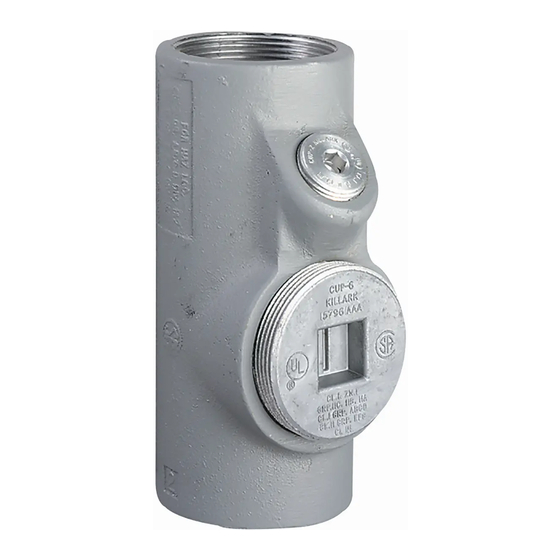Advertisement
Sealing fittings are installed in conduit runs to minimize the passage of gases, vapors, or flames from one portion of the electrical
installation to another through the conduit, as well as to prevent precompression or "pressure-piling" of vapors or gases in conduit systems.
NOTE: Seals should be made only by experienced, careful persons in strict compliance with these instructions. Even slight variations can
cause serious field problems. Read directions completely.
DIRECTIONS FOR INSTALLATION
Using the drawings and chart at the right as a guide, install the sealing
fitting into the conduit system. Refer to the National Electrical Code,
Articles 501-5 and 502-5 for the regulations covering your specific
application.
Pull the conductors (wires) through the conduit system.
Using Killark Type "PF" Packing Fiber, build a dam at each conduit hub
(except upper hubs in vertical seals.) Use a wooden stick to force the
wires apart, and pack the fiber tightly around all wires. The dam must be
tight and strong enough to keep the liquid sealing compound from leaking
out before it sets up. The completed dam should be even with the conduit
stop.
Use ONLY Killark Type "SC" Sealing Compound with these fittings. The
sealing compound is mixed with water at the rate of three (3) parts of
sealing compound to one (1) part of water by volume. See chart to
determine the amount of compound required for a specific fitting. Use a
clean mixing vessel for each batch. Sprinkle the sealing compound into
the water while stirring, until a thick paste is formed. Continue mixing for
AT LEAST THREE (3) MINUTES. The proper consistency is just fluid
enough to pour SLOWLY, like thick gravy, from an inverted container,
NOT WATERY. Do not mix more material than can be poured in 15
minutes. Discard any material that becomes too stiff to use. Never
attempt to restore workability by stirring in more water.
After the compound is mixed, slowly pour it into the sealing fitting to the
required level. Make sure that the wires are well separated, so the
compound completely surrounds them. Pour slowly to avoid trapping air
bubbles in the compound. Immediately wipe any spilled compound from
conduits and threads, and close the fitting with the close-up plug. Make
sure the plugs are tight.
Initial set of the sealing compound will occur within thirty (30) minutes.
However, the compound requires a minimum of 8 hours above 32° F to
develop sufficient strength to withstand explosion pressures.
P/N 00911850 FORM NO. KO687 R01/06 ECO-8-021-04
INSTALLATION, OPERATION & MAINTENANCE DATA SHEET
TYPE "ENY" HORIZONTAL / VERTICAL SEALING FITTING
SUITABLE FOR CLASS I, DIV. 1 & 2, GROUPS A, B, C & D
AND CLASS II, DIV. 1 & 2, GROUPS E, F & G HAZARDOUS LOCATIONS.
CAT. NO.
ENY-1
ENY-2
ENY-3
ENY-4
ENY-5
ENY-6
Killark Electric Manufacturing Company
A Subsidiary of Hubbell Incorporated
3940 Dr. Martin Luther King Drive
St. Louis, MO 63113
*
NOTE: These fittings are approved for use only with Killark "SC" Sealing Compound.
CONDUIT SIZE
MIN. POUR
½"
¾"
1"
1¼"
1½"
2"
APPROX. AMOUNT MIXED
DEPTH
COMPOUND REQ'D. (OZ.)
⅝"
¾"
1"
1¼"
1½"
2"
1.0
1.5
2.5
5.5
7.5
10.5
Page 1 of 2
Advertisement
Table of Contents

Summary of Contents for Hubbell Killark ENY Series
- Page 1 Killark Electric Manufacturing Company A Subsidiary of Hubbell Incorporated 3940 Dr. Martin Luther King Drive St. Louis, MO 63113 INSTALLATION, OPERATION & MAINTENANCE DATA SHEET TYPE "ENY" HORIZONTAL / VERTICAL SEALING FITTING SUITABLE FOR CLASS I, DIV. 1 & 2, GROUPS A, B, C & D AND CLASS II, DIV.
- Page 2 IOM - "ENY" Sealing Fitting OPERATIONAL DATA In humid atmospheres or wet locations, where it is likely that water could enter the interior enclosures or conduit runs, or where temperature and/or barometric changes can produce condensation or moisture within the conduit system, raceways should be inclined so that the water will not collect in seals.














Need help?
Do you have a question about the Killark ENY Series and is the answer not in the manual?
Questions and answers